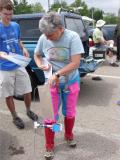
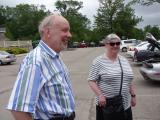
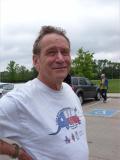
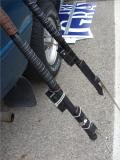
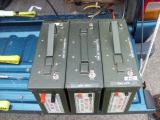
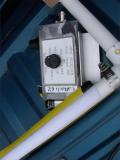
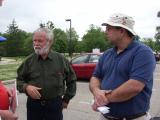
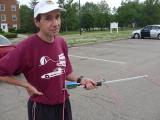
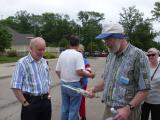
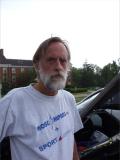
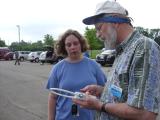
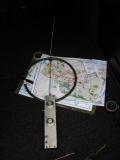
Jen and I competed in the 10th United States ARDF Championships held May 21-23, 2010 in southern Ohio. This is the eighth USA championships that Jen and I have attended. The competition was held in two locations near the college town of Oxford, Ohio, the home of Miami University. This is the second time that the championships have been held in the greater Cincinnati area. Jen came home with gold medals in both W35 competitions, and Ken came home with silver medals in both M21 competitions.
These photos are copyright © 2010 Kenneth E. Harker. All rights reserved.
Friday, May 21, was the practice day. On the practice day, the organizers put out transmitters that are identical to the transmitters that will be in the field on the competition days. They are placed in a smaller area than the area in which the competition days will be held. Competitors are given a map of the area and can use the opportunity to familiarize themselves with the kind of terrain they will encounter on course. The practice day is also an opportunity to test and adjust the radio receiver gear for optimal performance.
 |
Ruth Bromer WB4QZG (W60) of North Carolina. The practice area was the western part of the Miami University campus, and our meeting area was a parking lot near some athletic fields. The spring academic term had ended the week before, so the campus was fairly quiet. |
 |
PA Nordwaeger SM0BGU (M70) and his wife Eva came to the championships from Stockholm, Sweden. PA was the first competitor to run in the new M70 category. I first met PA in Korea as a fellow juror at the 2008 World ARDF Chmpionships. |
 |
Jay Hennigan WB6RDV (M50) came to the championships from Santa Barbara, California. He is wearing the T-shirt from the 2008 USA ARDF Championships held in Bastrop, Texas. |
 |
Some of the 3.5 MHz transmitter antennas, ready for deployment. For 3.5 MHz, the antennas used were shortened verticals with a small number of radials. The verticals are held up with telescopic fiberglass fishing poles. The small plastic box contains a matching network and the coax connector. |
 |
Some of the 3.5 MHz transmitters. Using Army surplus ammunition cases is a popular way to keep a battery, radio, and transmitter controller waterproof and animal-proof out in the woods. |
 |
A Ron Graham Electronics receiver for 144 MHz, sitting underneath a Yagi antenna. The receiver was designed and built by Australian Ron Graham VK4BRG, and is probably at least 10 years old. More recent version of the RGE receiver have digital displays and internal battery holders. |
 |
Marvin Johnston KE6HTS and Matt Robbins AA9YH (M40). Marvin drove to the championships from southern California and ran the electronic scoring system for the event. Matt was a course setter for one of the competition courses, but ran as competitor in the other one. Matt lives in Cincinnati, Ohio. |
 |
Bryan Ackerley VK3YNG came to the championships from Melbourne, Australia. Prior to arriving in Ohio, Bryan spent several days exploring Yosemite National Park in California. The blue receiver on his antenna is one that he designed himself; he has sold hundreds of receivers to ARDF enthusiasts all over the world. |
 |
PA Nordwaeger SM0BGU (M70) examines the homemade 3.5 MHz receiver of Dale Hunt WB6BYU (M50). Dale is the IARU Region II ARDF Coordinator. A unique feature of this receiver is the tuning knob, which is countersunk into the bottom of the tubular case in such a way that it is nearly impossible to accidentally bump it and change frequency while on course. Dale runs in the M50 category and came to the championships from the Oregon wine country. |
 |
Bob Cooley KF6VSE (M60) came to the championships from northern California. Bob was the course setter for the 2007 USA ARDF Championships in South Lake Tahoe, and has represented the USA at several World ARDF Championships. |
 |
Jen Harker W5JEN (W35) and Dale Hunt WB6BYU (M50) examine a 3.5 MHz receiver that Jen is building from a kit based on a design published in an article Dale wrote for QST in September, 2005. |
 |
An Ukrainian 3.5 MHz receiver sitting on top of maps from the 2009 USA ARDF Championships in Boston, Massachusetts. |
Saturday, May 22, was the 144 MHz Competition Day. The 144 MHz competition was at Hueston Woods State Park, north of Oxford. The state park includes 3,000 acres (12 km2) of woods and has a large lake in the middle of the park with a big lodge. We gathered at the lodge parking lot in the morning and were shuttled to the start area a few miles away. The finish area turned out to be close to where we parked. Big thunderstorms had come through the area on Thursday, so the ground in the woods was still very muddy.
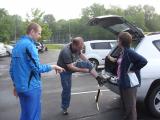 |
Several Germans made the trip to Ohio for the USA championships. From left to right: Jens Pichler DH2SP (M21), Harald Dettling DC1GB (M21), and Susanne Walz DG4SFF (W35). |
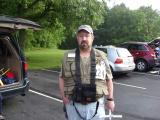 |
This was Woody Woodbury KC9CGN's (M50) first ARDF competition. Woody enjoys car-based foxhunting and came to the championships from northeast Indiana. |
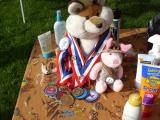 |
Ardy Fox and his friend Hamlet. Ardy is the mascot of Team USA and has come to all of the USA ARDF championships. |
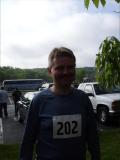 |
Leszek Lechowicz NI1L (M40) came to the championships from eastern Massachusetts. Leszek would get a silver medal in the M40 category on 144 MHz. |
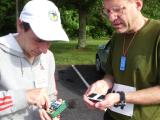 |
Bryan Ackerley VK3YNG (M21) and Mike Minium (M50). Mike, an experienced orienteer from Ohio, was a first time ARDF competitor. He used a borrowed VK3YNG receiver for the 144 MHz competition. Even though Mike is not a licensed amateur radio operator, competing with receive-only equipment is legal. Many ARDFers who come to the sport through orienteering eventually get their own amateur radio licenses. |
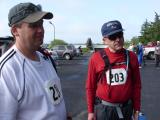 |
Brian Jansen KC9GMW (M40) and Paul Gruettner WB9ODQ (M50). Brian and Paul both came to the championships from Wisconsin. Paul first entered a USA ARDF Championship in 2007, but this was Brian's first ARDF event. Brian would earn a bronze medal in the 144 MHz competition. |
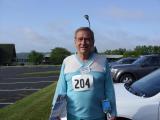 |
Jay Hennigan WB6RDV (M50). The board in Jay's right hand is a recycled political campaign sign that Jay cut to 17" x 11" to hold the large format maps we would be given just before our start. |
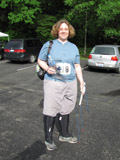 |
Jen Harker W5JEN (W35). Her receiver on 144 MHz is a Chinese model
that incorporates a three-element Yagi antenna with a receiver built into
the antenna boom. There is no on-off switch; plugging or unplugging
the headphones turns the radio on or off.
[Photo by Ilonka Zaharieva] |
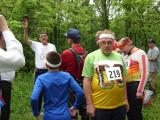 |
The start area was on a wet, muddy trail in the woods near the park entrance. In the foreground, the young man in blue facing away from the camera is Addison Bosley KJ4VCV (M19), a seventh grader who had some fantastic finish times. To the right is Addison's grandfather, Dick Arnett WB4SUV (M60) from northern Kentucky. Dick was one of the organizers of the championships, and one of the course setters for the 3.5 MHz competition. Since he was ignorant of the 144 MHz course details, he could participate as a competitor. |
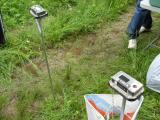 |
The championships used the SportIdent system for electronic scoring. Competitors carried a small memory stick (most often on an elastic band on one finger) that they put into control boxes like these to "punch in" at a control. These are the Clear and Check controls at the start, used to make sure competitors' "sticks" are ready to use on a new course. |
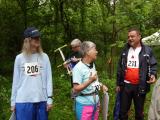 |
From left to right: Judy Taylor WD8EOP (W50), Ruth Bromer WB4QZG (W60), and Valeri Gueorguiev (M50). Judy came to the championships from West Virginia, and was running in her first ARDF event. Valeri came from Montreal, Canada, and was attending his third USA ARDF Championships. Valeri learned the sport of ARDF in his native Bulgaria, but only became active again in 2008. He will represent Canada in the 2010 World ARDF Championships in Croatia in September. |
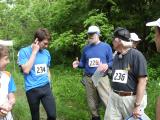 |
From left to right: Ian Smith (M21), Dale Hunt WB6BYU (M50), and Barry Fox W1HFN (M60). Ian and Barry both came to the championships from the greater Boston, Massachusetts area. Ian has been learning ARDF under the coaching of Vadim Afonkin KB1RLI, the organizer of the 2009 USA ARDF Championships. |
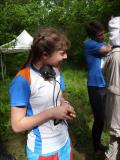 |
Lori Huberman (W21). Also from eastern Massachusetts, Lori has been a member of Team USA at the World University Orienteering Championships (WUOC). Lori has also been learning ARDF with the help of Vadim. Lori and Ian are both relatively recent graduates of the Massachusetts Institute of Technology. |
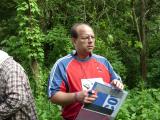 |
Matthew Robbins AA9YH (M40). One of the organizers of the championships, Matthew was a course setter for the 3.5 MHz course, but (like Dick Arnett WB4SUV) ran the 144 MHz course as a competitor. Matthew would beat out Matthias Kuehlewein DL3SDO for the gold medal on 144 MHz by a margin of just 5 seconds. |
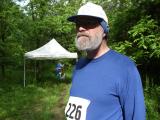 |
Dale Hunt WB6BYU (M50) gets his game face on. The M50 category had the most competition for those trying to qualify for the Team USA roster for the 2010 World ARDF Championships. |
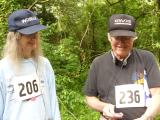 |
Judy Taylor WD8EOP (W50) and Barry Fox W1HFN (M60). Barry was a spectator at the 2009 USA ARDF Championships in Boston. An experienced car-based foxhunter, Barry was trying ARDF in the woods for the first time. |
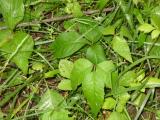 |
Poison Ivy was prolific in the woods of southwest Ohio. |
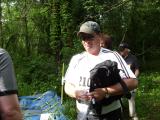 |
Brian Jansen KC9GMW (M40) getting ready for his start. Competitors start in five minute intervals, so no two competitors in the same class start at the same time. Some competitors had to wait up to an hour after the first start for their turn to start. Brian has a red SportIdent "stick" on the ring finger of his left hand. |
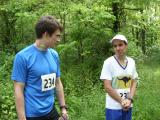 |
Ian Smith (M21) and Bryan Ackerley VK3YNG (M21). Bryan could run in the M40 category, but as he was not trying to qualify for Team USA, he decided to enter the M21 category (which has to find one more hidden transmitter) for the extra challenge. Bryan would beat Ian on 144 MHz, but Ian would beat Bryan on 3.5 MHz. |
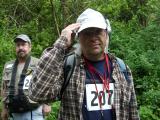 |
Bill Smathers KG6HXX (M50) came to the championships from Santa Barbara, California. |
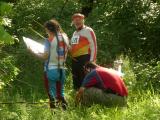 |
One of the first groups to start included Lori Huberman (W21), Guy Olsen (M50), and Matthew Robbins (M40). Guy is an experienced orienteer from New Jersey, and this was his second major ARDF competition. |
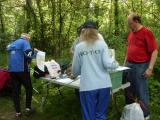 |
Runners at the start table. Competitors are called to the start table ten minutes before their official start time to collect their maps. Most competitors tape their maps to a board so they have a rigid surface on which to mark bearings taken with their receivers. |
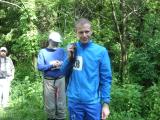 |
Jens Pichler DH2SP (M21) came to his first USA ARDF Championships as a guest competitor from Germany. To encourage more competitors from abroad, the last two USA championships have waived entry fees for non-USA entrants. |
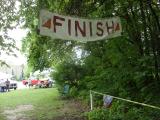 |
The finish line of the 144 MHz competition. |
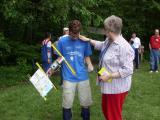 |
At the finish line, April Moell WA6OPS met every runner to make sure that there were no wounds or other medical conditions needing attention. April has volunteered as the Field Medic for all of the USA ARDF Championships. Here, she is attending to Adam White (M19). From Cincinnati, Ohio, this was Adam's first ARDF competition. Adam attached his map board directly to the antenna, rather than carrying it in another hand. |
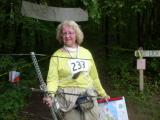 |
Karla Leach KC7BLA (W60) at the 144 MHz competition finish line. Karla and her husband Harley Leach KI7XF (M60) came to the championships from Bozeman, Montana. Karla has been to several world championships as a competitor for Team USA. |
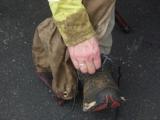 |
It was very muddy, especially on the trails and trying to climb up out of reentrants. |
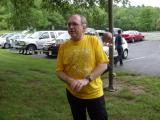 |
Guy Olsen (M50) changed into an orienteering T-shirt after finishing his run. Guy came in fifth place on the 144 MHz course. |
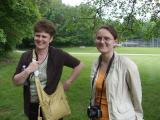 |
Valeri Gueorguiev's wife Snejina and daughter Ilonka came with him on the trip to Ohio from Montreal. Ilonka is a college student and photography buff. |
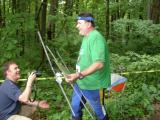 |
Csaba Tiszttarto (M40) crosses the 144 MHz finish line. Csaba lives in New York. |
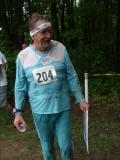 |
Jay Hennigan WB6RDV (M60) just after he finished on 144 MHz. |
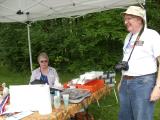 |
April Moell WA6OPS and Joe Moell K0OV are from southern California. Joe is the ARRL ARDF Coordinator. Among other responsibilities, Joe organizes the selection process for determining the members of Team USA at the World Championships and guides the sanctioning of a USA Championships event each year. |
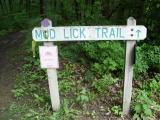 |
The finish corridor came down "Mud Lick Trail." No kidding! |
Sunday, May 23, was the 3.5 MHz Competition Day. The 3.5 MHz competition was at Bachelor Wildlife and Game Reserve, on the east side of the town of Oxford. The Reserve is managed by Miami University, and includes most of the watershed of a creek called Harker's Run, which drains into Talawanda Creek. As with the 144 MHz Competition day, we all parked near the finish area at Harker's Run and were shuttled to the start area a few miles away.
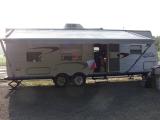 |
The finish area for the 3.5 MHz competition was near a gravel parking lot by a bridge over Harker's Run. One of the local volunteers brought an RV to use as a sort of base camp for the organizers. |
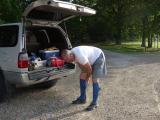 |
Brian DeYoung K4BRI (M40) adjusts his gaiters. From northern Kentucky, Brian was one of the organizers of the championships and a course setter for the 144 MHz competition. He entered the 3.5 MHz competition in the M40 class. |
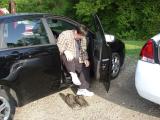 |
Bill Smathers KG6HXX (M50) also getting his footwear in order prior to the shuttle pickup. Bill had a much better run on the second day of competition. |
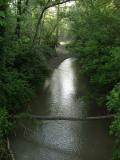 |
Next to the parking area was a bridge over Harker's Run This is the view looking upstream. Unbeknownst to us at the time, we would be getting to know this creek very well. |
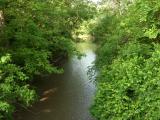 |
The downstream view of Harker's Run. |
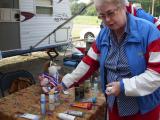 |
April Moell WA6OPS gets the first aid supplies out, including a variety of sunscreens and bug repellents for anyone who wanted some. |
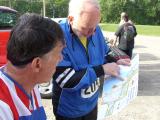 |
PA Nordwaeger SM0BGU (M70) discusses the previous day's 144 MHz course with Bob Frey WA6EZV (M60). A southern Ohio resident, Bob was one of the course setters for the 144 MHz course, but was running as a competitor on 3.5 MHz. Bob is a past member of Team USA. |
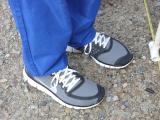 |
The very clean shoes of Bryan Ackerley VK3YNG (M21). We were all encouraged to wash our clothing and shoes after each competition day just in case they were contaminated with poison ivy. |
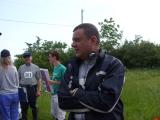 |
Valeri Gueorguiev (M50) at the start area. Just like the 144 MHz competition day, the start area was a few miles from the finish, and competitors were shuttled to the start. The 3.5 MHz start area was near a field laboratory and some experimental gardens. |
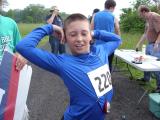 |
Addison Bosley KJ4VCV (M19) just before his start. Addison had a fantastic finish ime on 3.5 MHz. |
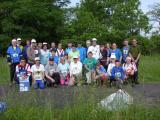 |
The competitors at the 3.5 MHz start. |
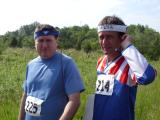 |
Csaba Tiszttarto (M40) and George Neal KF6YKN (M50). Csaba and George came to the championships from New York City. Originally from Hungary, George is one of the top USA competitors. He earned a bronze medal on the 3.5 MHz course in the 2008 World Championships in Korea. |
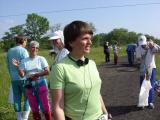 |
Susanne Walz DG4SFF (W35). The morning was warmer than it was the day before, with bright sunshine and no shade at the start area. |
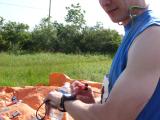 |
Ian Smith (M21) sets his watch prior to his start. Ian probably never needs to worry about going overtime on course, but having an accurate clock is important for knowing when the next transmitter cycle is going to begin. This is especially important if you are at one end of a course and cannot easily hear a transmitter at the far end of the course. |
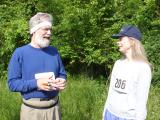 |
Dale Hunt WB6BYU (M50) and Judy Taylor WD8EOP (W50) talking before the start. |
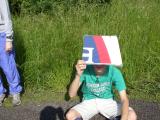 |
Adam White (M19) uses his map board (a recycled political sign) to provide some shade from the sun. |
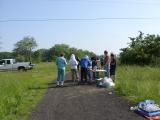 |
A group of runners at the start. The start corridor went off to the right, behind a line of trees and bushes that prevented those waiting for their turn to start from seeing the runners take their first bearings. |
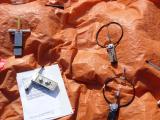 |
Some 3.5 MHz receivers in the impound. The two on the left use ferrite rod antennas and the two on the right use magnetic loop antenna designs. The receiver in the upper left is home-made, the other three are European models. |
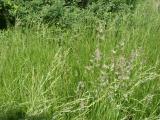 |
Some of the tall grass in the field next to the road. |
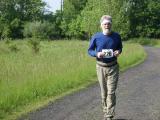 |
Dale Hunt WB6BYU (M50) jogs a bit to warm up. |
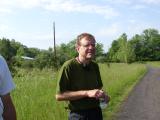 |
Mike Minium (M50). It was a warmer day on Sunday, so Mike is doing a smart thing by drinking water to hydrate before going on course. |
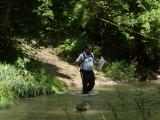 |
The finish corridor crossed Harker's Run. This is Brian Jansen KC9GMW (M40) coming in to the water. For most runners, it was less than knee depth, but everyone got very wet. It was not as cold as I was expecting. |
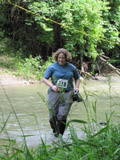 |
Jen Harker W5JEN (W35) crosses Harker's Run on her way to the finish line.
[Photo by Ilonka Zaharieva] |
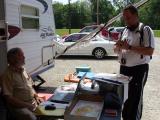 |
Marvin Johnston KE6HTS ran the electronic scoring system. After finishing, competitors would go to this computer to download their memory stick's data into the computer via the red SportIdent box. A small black and gray printer next to the SportIdent box printed out a results sheet for each runner to see their split times between controls. |
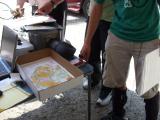 |
Adam White (M19) downloads his data into the scoring computer. |
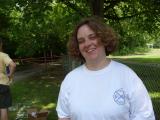 |
Jen Harker W5JEN (W21). Jen and I were the only competitors from Texas. |
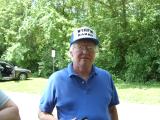 |
Barry Fox W1HFN (M60). |
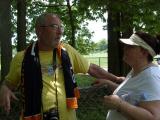 |
Brian DeYoung K4BRI (M50) and Marji Garrett (W50). This was Marji's first ARDF event. |
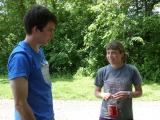 |
Ian Smith (M21) and Lori Huberman (W21). |
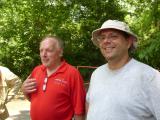 |
Dick Arnett WB4SUV (M60) and Matthew Robbins AA9YH (M40), the course setters for the 3.5 MHz competition. They're clearly feeling happy about the finish corridor. |
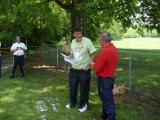 |
Bob Frey WA6EZV (M50) and Dick Arnett WB4SUV (M60) emceed the awards ceremony at the finish area as soon as all the runners from the 3.5 MHz competition were in. |
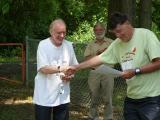 |
PA Nordwaeger SM0BGU (M70) receives the first ever medal awarded in the M70 category at a USA ARDF Championships. |
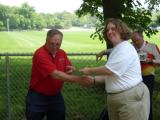 |
Jen Harker W5JEN (W21) receives her gold medal for the 144 MHz competition. |
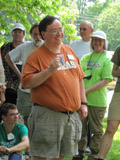 |
Ken Harker WM5R (M21) receiving a silver medal for the 3.5 MHz competition.
[Photo by Ilonka Zaharieva] |
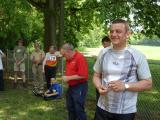 |
Valeri Gueorguiev (M50) came in third on 144 MHz and second on 3.5 MHz. |
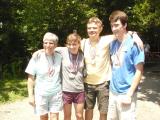 |
Ruth Bromer WB4QZG (W60), Lori Huberman (W21), Leszek Lechowicz NI1L (M40), and Ian Smith (M21). |
|
Last Updated 26 June 2020 wm5r@wm5r.org |